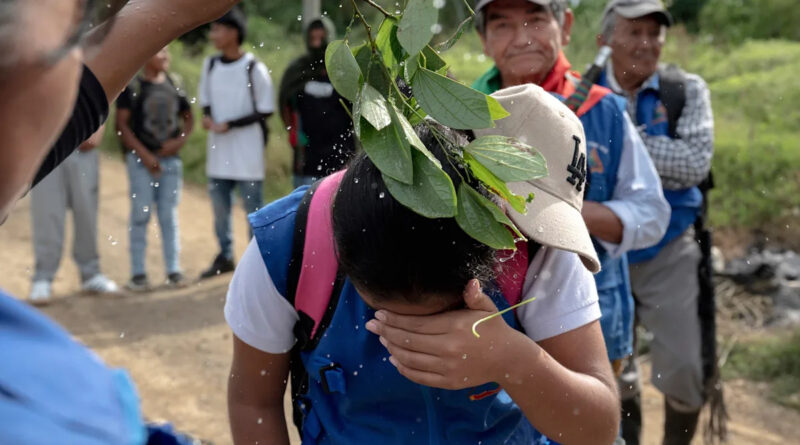After taking back land in Colombia, Indigenous prepare their youth to safeguard it
CALOTO, Colombia (AP) — Indigenous Nasa children are gently splashed with water using a leafy branch — a ritual meant to protect them and symbolically “open the path” — before setting off with wooden signs they had painted with messages like “We were born to protect the environment” and “Peace, please.”
Wearing protective gloves, the children nail their signs to trees lining a dirt road still used at times by armed groups for drug trafficking, as they collect trash from land their families reclaimed from vast industrial sugarcane plantations in Colombia’s conflict-scarred southwest.
This is no ordinary schoolyard activity. It’s a quiet act of defiance — and a hands-on lesson in protecting land and culture.
Just beyond the reclaimed land of the Indigenous López Adentro reserve, near the town of Caloto, a spray-painted warning on a wall orders drivers to keep their windows rolled down or risk being shot. It’s to allow armed groups to see inside.
Roadside banners declare support for dissident factions of the Revolutionary Armed Forces of Colombia (FARC), the leftist guerrilla group that signed a peace agreement with the government almost a decade ago. Violence in Cauca — and many other regions — has intensified since the 2016 peace deal, as criminal groups and FARC breakaway factions fight for territory and control over lucrative drug trafficking routes once held by the demobilized rebels.
The children’s “semillero” — a weekend school where Indigenous youth are nurtured like seeds — prepares the next generation to protect their ancestral land. More than a classroom, it’s a space for learning resistance, environmental care and cultural pride. Their work echoes a broader community effort to restore damaged territory and preserve identity in a region still marked by conflict.
Daniela Secue, a 26-year-old coordinator and leader of the semillero, said such training is essential as young people face so many challenges in their homeland.
“Without alternatives, some end up drawn to armed groups. But here, we teach them to protect the land through respect and care — not conflict,” Secue said. “We want them to learn our history and know they have a role in defending our territory. This is their inheritance.”
Reclaiming ancestral land
In 2019, dozens of Nasa families forcibly reclaimed nearly 350 hectares (about 865 acres) of land in northern Cauca that had been planted with sugarcane for years. The industrial monoculture had exhausted the soil and polluted water supplies with agrochemicals. The families’ removal of sugarcane marked a turning point — transforming degraded fields into plots for corn, rice, cassava, beans and plantains, alongside areas for forest regeneration and small-scale livestock raising.
The children wrapped up their sign-posting near an old finca, a rural estate once owned by a powerful sugarcane landlord. Faded FARC graffiti still marks the outer walls, a remnant of years of armed conflict. But today, a flag bearing the red and green of the Nasa people flies near it. The building, now crumbling and abandoned, is a dilapidated testament to the violence this land has endured.
Children play on old sandbags left behind by the military during a recent occupation meant to repress the community’s efforts to reclaim the territory.
The families’ 2019 takeover of the territory saw them arriving with machetes and cutting down the vast sugarcane crops, which are used to produce sugar, ethanol and panela — a traditional unrefined cane sugar often sold in solid blocks and widely consumed across Colombia.
Colombia has taken steps to empower Indigenous groups. But land takeovers like the one in López Adentro have sparked controversy, with critics — especially from agribusiness and government sectors — arguing that such occupations violate property rights and risk fueling further conflict. While Indigenous communities describe the actions as a legitimate reclamation of ancestral land, the national government has warned that land reform must follow legal channels and condemned unauthorized occupations.
Ecological changes after sugarcane
Members of the Indigenous guard say birds and other wildlife have returned to the area that was once only sugarcane.
Yet the struggle is far from over.
The community has endured forced evictions, military occupation, and threats from paramilitary groups.
One resident, Carmelina Camayo, 49, remembers when the soldiers occupied the old finca for three years. Though the military withdrew in 2024, the threat of eviction looms once more, with the landowner preparing new legal action.
“We didn’t survive all this to give up now,” Camayo said. “We have to continue resisting.”
The semillero’s work embodies that resistance. Secue said it’s not only about healing the land but reclaiming identity. Many former semillero members have grown to become leaders within the Indigenous Guard, protecting both people and territory.
“In a region where youth are vulnerable to violence and recruitment, we offer a different path — one of responsibility, belonging and connection to our ancestors,” Secue said.
For families like Secue’s and Camayo’s, hope rests on the next generation.
“We recover land so our children can eat from it and live on it,” Camayo says. “Even when we are gone, they will know what they belong to.”
___
The Associated Press’ climate and environmental coverage receives financial support from multiple private foundations. AP is solely responsible for all content. Find AP’s standards for working with philanthropies, a list of supporters and funded coverage areas at AP.org.
